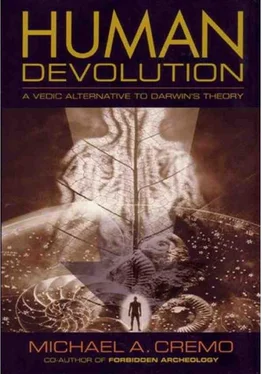Michael Cremo - Human Devolution - A Vedic Alternative To Darwin's Theory
Здесь есть возможность читать онлайн «Michael Cremo - Human Devolution - A Vedic Alternative To Darwin's Theory» весь текст электронной книги совершенно бесплатно (целиком полную версию без сокращений). В некоторых случаях можно слушать аудио, скачать через торрент в формате fb2 и присутствует краткое содержание. Год выпуска: 2003, ISBN: 2003, Издательство: Torchlight Publishing, Жанр: Старинная литература, на английском языке. Описание произведения, (предисловие) а так же отзывы посетителей доступны на портале библиотеки ЛибКат.
- Название:Human Devolution: A Vedic Alternative To Darwin's Theory
- Автор:
- Издательство:Torchlight Publishing
- Жанр:
- Год:2003
- ISBN:9780892133345
- Рейтинг книги:4 / 5. Голосов: 1
-
Избранное:Добавить в избранное
- Отзывы:
-
Ваша оценка:
- 80
- 1
- 2
- 3
- 4
- 5
Human Devolution: A Vedic Alternative To Darwin's Theory: краткое содержание, описание и аннотация
Предлагаем к чтению аннотацию, описание, краткое содержание или предисловие (зависит от того, что написал сам автор книги «Human Devolution: A Vedic Alternative To Darwin's Theory»). Если вы не нашли необходимую информацию о книге — напишите в комментариях, мы постараемся отыскать её.
Human Devolution: A Vedic Alternative To Darwin's Theory — читать онлайн бесплатно полную книгу (весь текст) целиком
Ниже представлен текст книги, разбитый по страницам. Система сохранения места последней прочитанной страницы, позволяет с удобством читать онлайн бесплатно книгу «Human Devolution: A Vedic Alternative To Darwin's Theory», без необходимости каждый раз заново искать на чём Вы остановились. Поставьте закладку, и сможете в любой момент перейти на страницу, на которой закончили чтение.
Интервал:
Закладка:
Q is necessarily related to the original density variations in the fireball of the early stages of the Big Bang. If there were no density variations at all, then the matter in the universe would have expanded completely evenly, so that there would have been no clumping of matter in the more dense regions. So according to the present value ofQ (one in a hundred thousand, i.e. 10-5), the initial variations in the energy of the Big Bang universe were no greater than one hundred thousandth of its radius. Scientists plan to confirm this with space satellites that can very accurately measure minute variations in the cosmic microwave background radiation, which scientists take to be the remnants of the original Big Bang fireball.
It turns out that Q’s present value (10-5) is just about the only one that allows for the kind of universe in which there can be stable stars and planets on which life as we know it could exist. What if Q were smaller than 10-5? Rees (2000, p. 115) said “the resulting galaxies would be anaemic structures, in which star formation would be slow, and inefficient, and ‘processed’ material would be blown out of the galaxy rather than being recycled into new stars that could form planetary systems.” If Q were still smaller (smaller than 10-6), then “gas would never condense into gravitationally bound structures at all, and such a universe would remain forever dark and featureless” (Rees 2000, p. 115). But what would happen if Q were much greater than 10-5? Rees (2000, p. 115) said in such a universe most matter would quickly collapse into huge black holes and any remaining stars “would be packed too close together and buffeted too frequently to retain stable planetary systems.” So although the current value of Q is critical for our existence, there is no particular reason why Q has that value. As Rees (2000, pp. 113–114) put it, “The way Q is determined . . . is still perplexing.”
I do not want to leave the impression that there are no problems with the general scenario of galaxy formation implicit in this discussion. Although scientists do believe that stars and galaxies form more or less automatically according to physical laws during the condensation of gas clouds in space, they have not been able to accurately model the process on computers. Rees (2000, p. 110) noted that “nobody has yet performed a simulation that starts with a single cloud and ends up with a population of stars.” In other words, the evidence for the fine tuning of constants combined with the inability of scientists to accurately model the process of star and galaxy formation may lead us to the conclusion that more is required than matter acting according to certain laws. The overall active intervention of a supreme being may also be required. In other words, God is not necessary just to fill in the gaps, but as an overall enabling and coordinating factor.
D : the number of Dimensions
The number of spatial dimensions, D , determines important features of our universe. For our universe Dis three. If Dwere two or four
482 Human Devolution: a vedic alternative to Darwin’s theory
or some other number, life as we know it could not exist.
In our universe gravity and electricity obey the inverse square law. If you move an object twice as far away from you as it is now, the force of its gravity upon you will be only one quarter of what it was. Four is the square of two (1/2 × 1/2), and one quarter is the inverse square of two (2 × 2). If the object is moved four times as far away, its gravitational force
becomes one sixteenth of what it was, one sixteenth being the inverse square of four.
In a four dimensional world, gravity would follow an inverse cube law instead of an inverse square law. This would have a devastating effect, according to Rees (2000, p. 135): “An orbiting planet that was slowed down—even slightly—would then plunge ever-faster into the Sun, rather than merely shift into a slightly smaller orbit, because an inverse-cube force strengthens so steeply towards the center; conversely, an orbiting planet that was slightly speeded up would quickly spiral outwards into darkness.” Only an inverse square law of gravity allows for stable orbits of planets. The same is true for orbits of electrons. If gravity and electromagnetism operated according to anything other than an inverse square law, there would be no stable atoms (Rees 2000, p. 136; Barrow and Tipler 1996, pp. 265–266).
If there were only two dimensions, it would be difficult for a functioning brain to exist. Barrow and Tipler (1996, p. 266), citing the work of Whitrow (1959), said, “He argues that if the spatial structure were of dimension two or less then nerve cells (or their analogues) would have to intersect when superimposed and a severe limitation on informationprocessing of any complexity would result.”
It also appears that reliable electromagnetic signaling (of the kind we use in radios, televisions, computers, and telephone systems, as well as in biological neural systems) is possible only in a three dimensional universe. Barrow and Tipler (1996, p. 268) explained, “In two-dimensional spaces wave signals emitted at different times can be received simultaneously: signal reverberation occurs. It is impossible to transmit sharply defined signals in two dimensions.” Reliable transmission requires not only that waves are without reverberation but also without distortion. Barrow and Tipler went on to say, “Three-dimensional worlds allow spherical waves . . . to propagate in distortionless fashion. . . . Only threedimensional worlds appear to possess the ‘nice’ properties necessary for the transmission of high-fidelity signals because of the simultaneous realization of sharp and distortionless propagation. . . . If living systems require high-fidelity wave propagation for their existence to be possible, then we could not expect to observe the world to possess other than three spatial dimensions.” Also, the gravity waves of Einstein’s general theory of relativity could only propagate in a universe with three spatial dimensions and one time dimension (Barrow and Tipler 1996, p. 273). A modern cosmological theory, string theory, relies on a universe with ten spatial dimensions and one time dimension; however, all but three of the spatial dimensions are compacted on the microscopic level and have no visible effect on wave propagation (Barrow and Tipler 1996, pp. 274–275).
How to explain the Fine tuning
The existence of a universe in which human life as we know it is possible depends on the fine tuning of several constants and ratios of physical forces. How did this fine tuning come about? Today, theorists recognize three main possibilities. First, the fine tuning in the universe of our experience might be determined by an as yet undiscovered physical law. Second, it could be that our universe is only one of an infinite number of universes, each with different values for the constants and ratios, and we just happen to be living in the one with the values that will allow life to arise. Third, the fine tuning could be the result of providential design. Let us now consider each of these possibilities, beginning with physical determination of the fundamental constants and ratios.
In modern cosmology, some theorists propose that the fine tuning of universal constants and ratios of fundamental forces of nature will eventually be predicted by a grand unified theory of everything. At the present moment the biggest obstacle to a theory of everything is the unification of quantum mechanics and Einstein’s general relativity theory. Quantum mechanics does very well in explaining the world of atoms and subatomic particles, where the main forces are electromagnetism, the atomic weak force, and the atomic strong force. Relativity theory does very well in explaining the action of gravity on the larger scale of the universe. At present no theory has successfully integrated both quantum mechanics and relativity theory, and this unification is especially necessary to explain the very early history of the Big Bang universe, when all the forces of nature were unified. One theory that promises to unify gravity with the other three fundamental forces is superstring theory. According to superstring theory, the basic units of matter are very tiny circular “strings” of energy. The various subatomic particles are strings vibrating at different frequencies in ten dimensional space. Superstring theorists claim that many of the fine tunings of fundamental constants and ratios of natural forces could be directly derived from the theory. But at the present moment there is no physical verification of superstring theory. “Strings” are many orders of magnitude smaller than the smallest subatomic particles visible in the biggest particle colliders. Rees (2000, p. 145) calls attention to the “unbridged gap between the intricate complexity of ten-dimensional string theory and any phenomena that we can observe or measure.” Until some kind of verification can be obtained, superstring theory remains in the realm of speculation and cannot be called upon to resolve the fine tuning problem.
Читать дальшеИнтервал:
Закладка:
Похожие книги на «Human Devolution: A Vedic Alternative To Darwin's Theory»
Представляем Вашему вниманию похожие книги на «Human Devolution: A Vedic Alternative To Darwin's Theory» списком для выбора. Мы отобрали схожую по названию и смыслу литературу в надежде предоставить читателям больше вариантов отыскать новые, интересные, ещё непрочитанные произведения.
Обсуждение, отзывы о книге «Human Devolution: A Vedic Alternative To Darwin's Theory» и просто собственные мнения читателей. Оставьте ваши комментарии, напишите, что Вы думаете о произведении, его смысле или главных героях. Укажите что конкретно понравилось, а что нет, и почему Вы так считаете.












